Revolutionizing engineering education: Creating a web-based teaching platform for immersive learning experiences
Abstract
Innovative pedagogy is more oriented towards the use of new technology in future education. Virtual and augmented realities, as well as the metaverse, are today the catalysts for the development of future teaching tools. They allow students to discover, via their smartphones or headsets, destinations around the world while remaining in their classrooms or even from their homes. These technologies are also used to put into practice, especially for the engineering sciences, lessons, and practical work by creating immersive experiences for users. This will significantly change the role of the teacher and the student in digital spaces. The realization of VR or AR learning platforms requires multidisciplinary skills ranging from 3D modeling to web and mobile platforms. In this paper, we present a method for creating a teaching platform for engineering sciences based on WebXR. We have created in our virtual environment a lesson about the Arduino board to train STEM students.
1.Introduction
One of the objectives of higher education is to prepare Science Technology Engineering and Mathematics (STEM) students for the industry by teaching them engineering, mathematics, science, and technology. These skills are essential for students to succeed in the workforce, where technology is used in various fields, including production and management.
The popularity of 2D technologies increased after the COVID-19 pandemic, which led to worldwide restrictions on social activities, including schools, work, and entertainment. As a result, people relied heavily on technologies like Zoom and Teams for meetings and classes. Researchers saw this as an opportunity to prove that physical presence is not always necessary as long as communication and data sharing can be achieved [11].
The next revolution after 2D technologies is 3D technologies, which provide more realistic methods that mimic the behavior of objects in real life. These solutions have several advantages, such as increasing student motivation and self-learning skills, building necessary skills, and reducing teaching duration. However, there are challenges, including controlling the duration, dependence on internet connectivity, and impacts on human social life and security.
It is interesting that teachers already have the ability to build interactive content for their students to improve their performance and increase their productivity using existing tools in the market [15]. However, it is not always evident for all teachers from different generations and technology levels to find it easy to build this kind of new innovative content, that is why we had the big question of how we can bring the best practices of teaching STEM in a 3D space and make it easy for the majority of teacher’s profiles as much as possible all in one place. Using our solution, we believe this will boost and take education 4.0 to another level [1].
In this paper, we present the first version of a teaching platform using virtual reality. We have created two profiles: teacher and student. The teacher can create content by integrating 3D models, annotations, texts, audios, and videos. The student can participate in the course and learn from the content provided by the teacher. We used the WebXR platform and implemented it on an Arduino UNO board.
The paper will be organized as follows: The first section is the introduction. The second part will discuss the related works concerning education in digital spaces. Part three will present the following methodology for the implementation and the use of the proposed platform. Part four is dedicated to the results. Finally, we will conclude and provide some perspectives on this work for future contributions.
2.Related works
In today’s education 4.0 landscape, higher education is undergoing a profound digital transformation. This section is dedicated to exploring the cutting-edge developments within this realm. We will specifically delve into immersive technologies like Virtual Reality (VR), Augmented Reality (AR), and Mixed Reality (MR). Additionally, we’ll introduce the intriguing concept of the metaverse, which is poised to play a pivotal role in the future of education.
2.1.Digital transformation in higher education: State of art
When we talk about the digital transformation in education 4.0 we talk about the recently innovated technology that we can find, like Virtual Reality allows a person to feel as though they have been transported to another place without physically changing their position or environment. The first VR experience was created in 1962 and allowed users to take a tour of the streets of New York [3]. Nowadays, people seek to enrich their environment and experiences without traveling or making a lot of effort. This is inspired by the way the human brain can believe in dreams subconsciously while sleeping.
To convince the brain that a human is transported to another place requires several elements. These include completely changing the visual elements in front of the eyes at a specific angle and distance [13], adding sound effects to the objects in the virtual environment, and enabling interaction with the virtual elements around the user.
Currently, VR is being used in a wide range of sectors, from gaming to commerce to education. The use cases can vary from employees using it in their work to end-users using it as a marketing solution or as a product to purchase.
We also talk about Augmented reality when a human sees objects that are not really in front of their eyes. AR is mainly used on mobile and tablets that are equipped with cameras. AR is different from VR as the objects need to be added to the real environment [2].
AR technically requires a camera and sensors to detect space and calculate the measurements, detect the light type and direction, and predict user interactions. For example, we can consider ARCore (Google) and ARKit (Apple) which work on almost all modern mobile operating systems.
There are others that we can find such as MR which are called interactive virtual objects with the real physical environment and augmented virtuality (AV), but in general the focus is on VR, AR and MR, which is why they are all called XR.
It is also important to mention the metaverse. This term was appeared in the novel Snow Crash in 1992 [16]. With the development of technology, metaverse experiments are in the building stage regarding some problems to solve, but a lot of mini metaverses exist and are accessible [9].
Some of the reasons why we are still building the metaverse are: building one metaverse, should be accessible anytime with the possibility to continue on the last status, real-time synchronization with the other users [5], the freedom to change from one metaverse platform to another, and more [10].
2.2.The perspective of the concerned actors of our study
Using XR technologies in education needs to be discussed from the perspective of the main actors. We talk about the students of which we want to improve their learning and the teachers who will want to create and design the courses. Students’ learning can vary based on many factors, such as prior experience with technology, learning preferences, and the specific context in which the use of AR and VR [8]. However, some common perspectives that students liked in the experience and found it useful are listed in the feedback in Table 1.
Table 1
Students’ feedback on using AR and VR in education [8]
| Feedback | Explanation |
| Increased engagement | Many students find that using AR and VR technology makes learning more engaging and interactive. By immersing themselves in a virtual environment, students may feel more connected to the material and more motivated to learn |
| Improved understanding | Using AR and VR technology can also help students better understand complex concepts and ideas. By visualizing abstract concepts in a three-dimensional space, students can gain a more intuitive understanding of the material. |
| Enhanced collaboration | AR and VR technology can also facilitate collaboration and teamwork among students. By allowing students to work together in a shared virtual environment, they can develop communication and problem-solving skills that are valuable in both academic and professional settings. |
| Technical challenges | While many students may enjoy using AR and VR for learning, some may also encounter technical challenges such as hardware limitations or software compatibility issues. These challenges can be frustrating and may hinder students’ ability to fully engage with the material. |
| Access and equity | It is important to consider issues of access and equity when using AR and VR technology for learning. Not all students may have equal access to these technologies, which can create disparities in learning outcomes. Additionally, some students may have disabilities or other challenges that make it difficult to use AR and VR technology effectively. |
By understanding these perspectives, educators and instructional designers can better design AR and VR experiences that meet students’ needs and support their learning [6].
The teachers on the other hand can also vary based on several factors, such as prior experience with technology, pedagogical approach, and the specific context in which they are using AR and VR. However, some common perspectives that teachers find it a promising technology as listed in Table 2 list the teacher perspective’s feedback.
Table 2
Teachers’ feedback on using AR and VR in education
| Feedback | Explanation |
| Increased engagement | Teachers may find that using AR and VR technology makes lessons more engaging and interactive for their students. By immersing students in a virtual environment or overlaying digital information in the real world, teachers can capture their students’ attention and motivate them to learn. |
| Improved learning outcomes | AR and VR technology can also help teachers achieve better student learning outcomes. By providing students with an interactive and immersive learning experience, teachers can help them develop a deeper understanding of complex concepts and ideas. |
| Enhanced collaboration | AR and VR technology can also facilitate collaboration and teamwork among students. Teachers can use these technologies to create shared virtual spaces where students can collaborate on projects or solve problems. |
| Technical challenges | While many teachers may find AR and VR technology to be valuable tools for teaching, some may also encounter technical challenges such as hardware limitations or software compatibility issues. These challenges can be frustrating and may require additional training or support. |
| Integration with curriculum | Teachers may also have concerns about integrating AR and VR technology with their curriculum. They may worry about whether these technologies align with their learning objectives or whether they have the necessary resources to effectively use them in the classroom. |
Overall, while teachers’ perspectives on using AR and VR to teach can vary, by understanding these perspectives, educators and instructional designers can better design AR and VR experiences that support teaching and learning. However, there is a lack of pedagogy implementation in this kind of high technology for higher education or specifically for STEM education. The key solution to move forward is to provide easy-to-use, user-friendly interfaces that can be used by teachers of any age or familiarity with the technology [17].
2.3.Virtual 3D technologies in STEM higher education
STEM stands for science, technology, engineering, and mathematics education for students after obtaining a high school degree, which takes an average of 12 years of study. The objective from the students’ perspective is to learn skills that will make them ready to join the industry [7,20].
The use of XR technology is becoming mandatory for many industries to boost their production. For example, technology is used for the training process of new employees, retrieving data in real-time, using AI and ML to predict trends and solutions, and communicating with fewer boundaries. The list is too long to mention here.
An example that we can elaborate on is using virtual reality for safety training in industries that involve working with hazardous materials or chemicals [14].
In conclusion, the integration of extended reality (XR) technologies is reshaping the educational landscape by offering immersive, interactive experiences. Students benefit from increased engagement, better understanding, and enhanced collaboration, yet technical challenges and equity issues must be addressed. Within STEM higher education, XR becomes indispensable in preparing graduates for the ever-evolving demands of various industries. It represents a transformative tool that promises to redefine the future of education and learning.
3.Methodology
In order to make XR technology accessible by all teachers’ profiles and with less effort to learn a new technology or under a low budget to buy fancy XR headsets, we think access to this technology needs to be democratized thanks to the web can be accessed from any device that has a browser and internet connection.
The methodology adopted for the development of a WebXR-based teaching platform tailored to immersive engineering education encompasses the seamless integration of virtual and augmented realities, leveraging the potential of the metaverse, and executing the WebXR platform, with a specific emphasis on crafting a focused lesson revolving around the Arduino board, targeting STEM students. Employing a multidisciplinary approach, the platform development process converges skills spanning 3D modeling, web and mobile platform development, and the art of educational content creation. The resultant platform, designed to foster interactive engagement between educators and learners, facilitates the creation, integration, and efficient delivery of a diverse array of immersive educational content. Content creation, a pivotal component, equips instructors to curate lessons utilizing an assortment of media, including 3D models, annotations, text, audio, and video, thereby cultivating a dynamic and enriching learning environment. The chosen WebXR platform’s versatility, catering adeptly to both smartphones and headsets, ensures a seamless and immersive learning experience for students while furnishing instructors with a versatile tool for effective content dissemination. A tangible illustration of the platform’s capabilities is presented through a hands-on Arduino board lesson, effectively showcasing the fusion of 3D models, annotations, and instructive media to engender insightful STEM education. The iterative process of evaluation and refinement guarantees not only the usability and functionality of the platform but also its educational efficacy, with valuable insights gleaned from both educators and students. Facilitating distinct profiles for educators and students, the platform grants educators the privilege of content creation and management, while empowering students with seamless course engagement and access to pertinent course material. This comprehensive methodology encapsulates the integration of the WebXR-based teaching platform, underscored by Arduino board-centered lessons, aimed at delivering captivating, interactive learning experiences within the realm of engineering.
Figure 1 visualizes the power of accessing the XR platform from the browser of any device it does not matter if the device supports 2D so the content will be projected or it supports 3D which is the perfect use case they get more benefit from the experience of Virtual reality. On the other hand, the application can be deployed as any web application in condition to support the libraries of WebXR.
4.Results
The teachers need to easily create their content with minimal effort and time to have a good quality course or training by adding assets; which can be 3D objects and/or 2D items previewed or heard on the browser to the created virtual session. On the other hand, the students can access the shared session by the teacher and get immersed in a multi-user space for real-time interaction.
One of the objectives is to get analytics of students so the teacher can follow up and be more of a facilitator than an instructor.
4.1.Supporting different resource types for learning
Having a limited choice to use multiple types of resources like videos, images, and audio... can be useful only in some specific cases as it depends on the objective to achieve.
AR and VR are not the only technologies named so far since we have extended reality that includes interaction level and behavioral statuses like the case of assistance and 360 images or videos. In addition to AR and VR, XR (Extended Reality) technology can also be used to teach STEM subjects in higher education. XR is an umbrella term that encompasses AR, VR, and other immersive technologies such as mixed reality (MR) and haptic feedback. Table 3 lists more details and types that can be supported using XR technologies.
Table 3
Types of support that AR, VR, and XR technology can offer to teach STEM subjects in higher education
| Type of support | Explanation |
| Immersive learning environments | AR, VR, and XR technology can provide students with immersive and interactive learning environments that allow them to explore and interact with STEM concepts more engagingly. For example, using MR technology, students can visualize 3D models of complex molecules or physics concepts, and manipulate them with hand gestures. |
| Collaboration | AR, VR, and XR technology can facilitate collaboration and teamwork among students, regardless of their physical location. This can be especially useful for STEM fields that require group projects and experiments. Using VR technology, students can meet in a virtual classroom or lab to work together on projects or solve problems. |
| Simulations and virtual labs | AR, VR, and XR technology can provide students with access to simulations and virtual labs that allow them to experiment with STEM concepts in a safe and controlled environment. This can be especially useful for STEM fields that involve hazardous or expensive experiments. |
| Personalization and adaptive learning | AR, VR, and XR technology can also be used to personalize learning experiences and adapt to students’ individual needs and learning styles. For example, using VR technology, teachers can create simulations that adjust the difficulty level of a task based on a student’s performance. |
| Real-world applications | AR, VR, and XR technology can provide students with real-world applications of STEM concepts, which can help them understand how the concepts they are learning in class relate to their future careers. For example, using AR technology, students can overlay digital information onto real-world environments to see how a construction project might look before it is built. |
Overall, AR, VR, and XR technology can provide various types of support to teach STEM subjects in higher education, which can enhance students’ learning experiences and improve learning outcomes.
4.2.Using the WebXR technology
WebXR is a term used to describe the use of extended reality (XR) technology on the web. It is an open standard that allows developers to create and publish AR and VR experiences that can be accessed through a web browser, without the need for users to download and install additional software [12]. WebXR is supported by major web browsers like Chrome, Firefox, and Safari, and it enables users to access immersive experiences on a variety of devices, including smartphones, tablets, and head-mounted displays (HMDs). WebXR can support a wide range of use cases, including education, entertainment, e-commerce, and more.
In the context of education, WebXR can offer several benefits for teaching and learning. For example, educators can use WebXR to create interactive and immersive educational content that can engage students and help them visualize and understand complex concepts. Students can access this content through their web browser, without needing to install any additional software.
WebXR can also enable collaborative learning experiences, allowing students to work together on projects and experiments in a shared virtual space. This can be especially useful for students who are studying in different locations or who are unable to attend in-person classes. In addition, WebXR can provide access to educational content for students who may not have access to expensive hardware or software. By accessing WebXR experiences through a web browser, students can use affordable devices to access high-quality educational content.
The goal is to have access whenever you have a browser that supports the XR features [4]. The benchmark report on WebXR technologies as of 11 November 2022 provides an idea of the current state of WebXR. Based on research Three.js is widely used for research purposes because of the available learning resources (Table 4).
Table 4
Benchmark between the technologies of WebXR
| Tech name | Category | Functionality | Difficulty (learning resources) | Scalability | Open source |
| A-Frame | Js framework | Building 3D/AR/VR | Easy | yes | |
| Babylon.js | Js framework | Real-time 3D game engine AR and gaze and teleportation support | Difficult | yes | yes |
| Three.js | Js framework | AR, VR | Easy | yes | |
| AR.js | Tool for Three.js | AR | Medium | yes | |
| Model viewer | HTML element | displaying 3D models in AR | Easy | yes | |
| p5.xr | An add-on for p5.js | VR / AR / 360 | Medium | yes | |
| A Js library | |||||
| Playcanvas | Game engine | VR | Difficult | yes | yes |
| react-xr | hooks using threejs for react js the Js framework | VR/ AR | Easy | yes | |
| WebXR Export | Unity WebXR extensions | VR / AR | Difficult | no | |
| Verge3D | Creating interactive 3D web with Blender | AR / VR | no | ||
| Wonderland Engine | Dev tool for WebXR | VR / AR | Medium | no | |
| Sumerian | Aws tool | VR | Medium | no |
4.3.The implementation of the proposed solution
After choosing the technology that can be used to develop our platform, tests were taken to figure out the limits of WebXR compared to the features that can be found in a native application. The result was promising; almost everything can be developed in browsers supporting XR.
These features are similar to what we can have in a native app for any headset brand for VR or AR. Three.js supports more than 50 3D object formats, but the most popular is glTF (glb the binary version for a smaller size). It gives access to the object meshes and materials so we can change, for example, the color or position. WebXR is a complex technology with many cinematic, mathematical, and philosophical complications. In the W3C, we can find the most up-to-date features of this technology [19].
Fig. 2.
Platform development ecosystem.
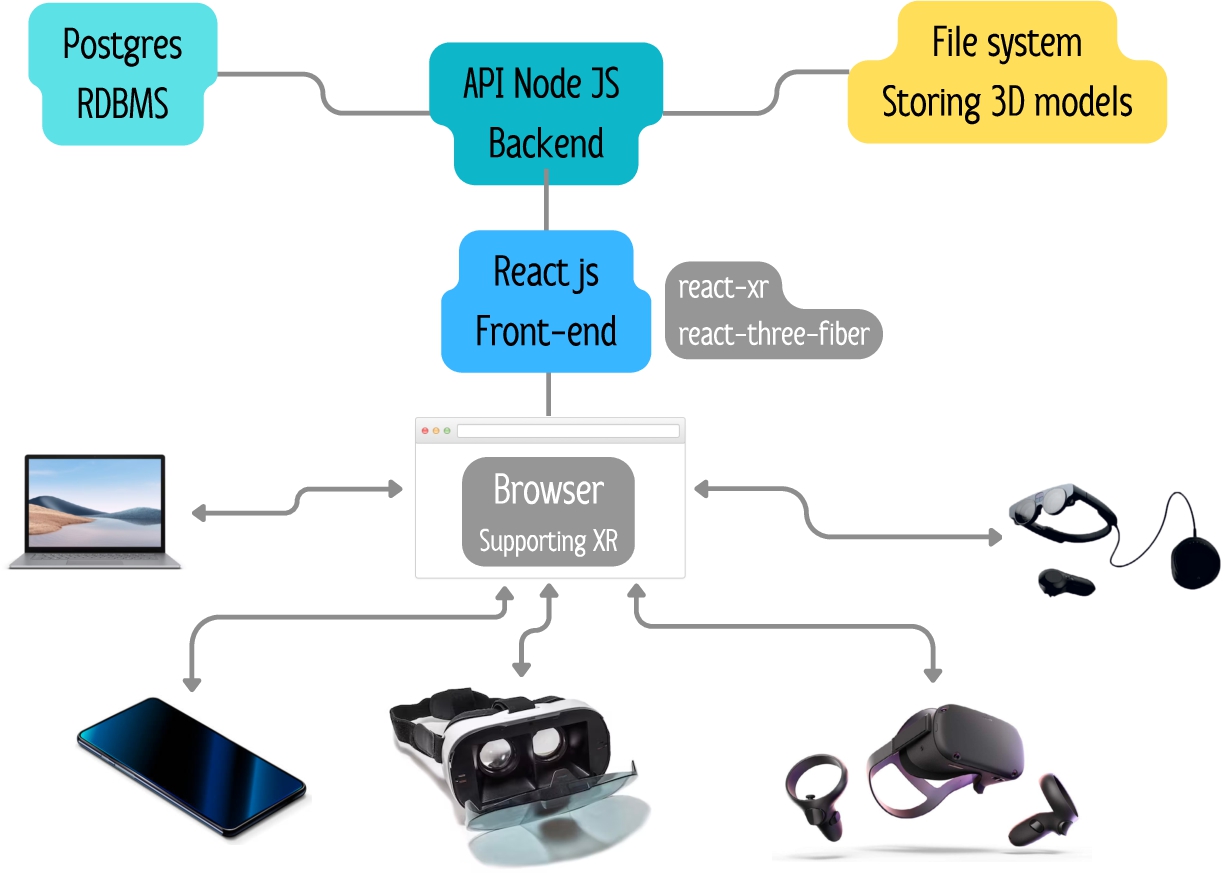
Figure 2 represents the development ecosystem that we are supporting to build the platform especially the technologies used:
− RDBMS: Postgresql will be used as a relational database to store all details about the admins, students, teachers, and courses.
− File system: In addition, we need to use a big data file system like Hadoop Distributed File System (HDFS) to store and manage heavy 3D models.
− Backend API: To interact with the database we need an API, Nodejs is an open-source, cross-platform JavaScript runtime environment for developing and also staying in the same language as the front-end which is javascript.
− Front-end: On the official website of WebXR in the section of Frameworks recommendations, ReactXR is listed, as a framework based on the three.js library that facilitates the construction of the front-end and creates the scenes [18].
− The end users UX/UI: Any teacher can access and manipulate his lessons from any device that has a web browser supporting xr technology which is the case for almost all modern devices.
The platform is supposed to help the teacher create good lessons according to recommendations of well-known methods based on research in education for STEM.
− Development environment: Working with JavaScript in both back-end and front-end will reduce development time to build the whole platform and focus on developing skills in specified areas like VR and AR technologies. Another advantage is that those skills are easy to find for future collaborators and they have a big and active community of developers.
The 3D manipulation needs to be about:
− Positions
− Rotations
− Hand-controls – in the case of HMD with controllers
− Controls for scene
− Scaling measures – based on the position of the users
− Material texture of the models
− Cursor events – for laptops
− Lights manipulations and interaction – for AR models
⋆ fog
⋆ geometry
⋆ raycaster
⋆ and more options
− Sound effects
− Models types and formats
⋆ gltf format
⋆ obj models
⋆ collada models
4.4.Demonstration
The first step is for the teacher to log in to the course using their email and password. The second step is for students to join the session using a code sent to their email or shared with them directly. Once everyone is connected, they can all view the same visual information by following the teacher’s interactions. In this demonstration, we use 3D models of an Arduino UNO card and electric motor (Figs 3–7).
Fig. 3.
List of courses depending on the teacher’s information.
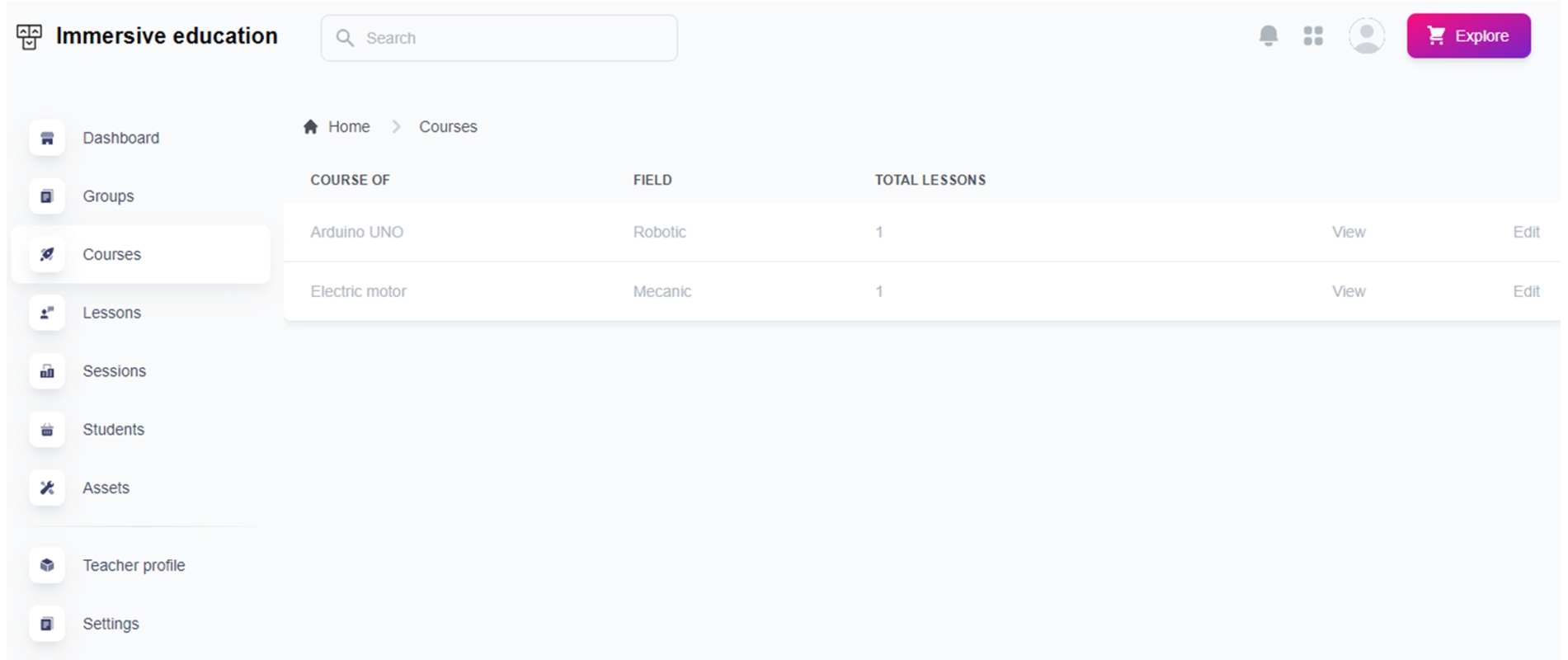
Fig. 4.
Annotations on 3D assets. Side view of annotations while moving around the 3D asset in the virtual space.
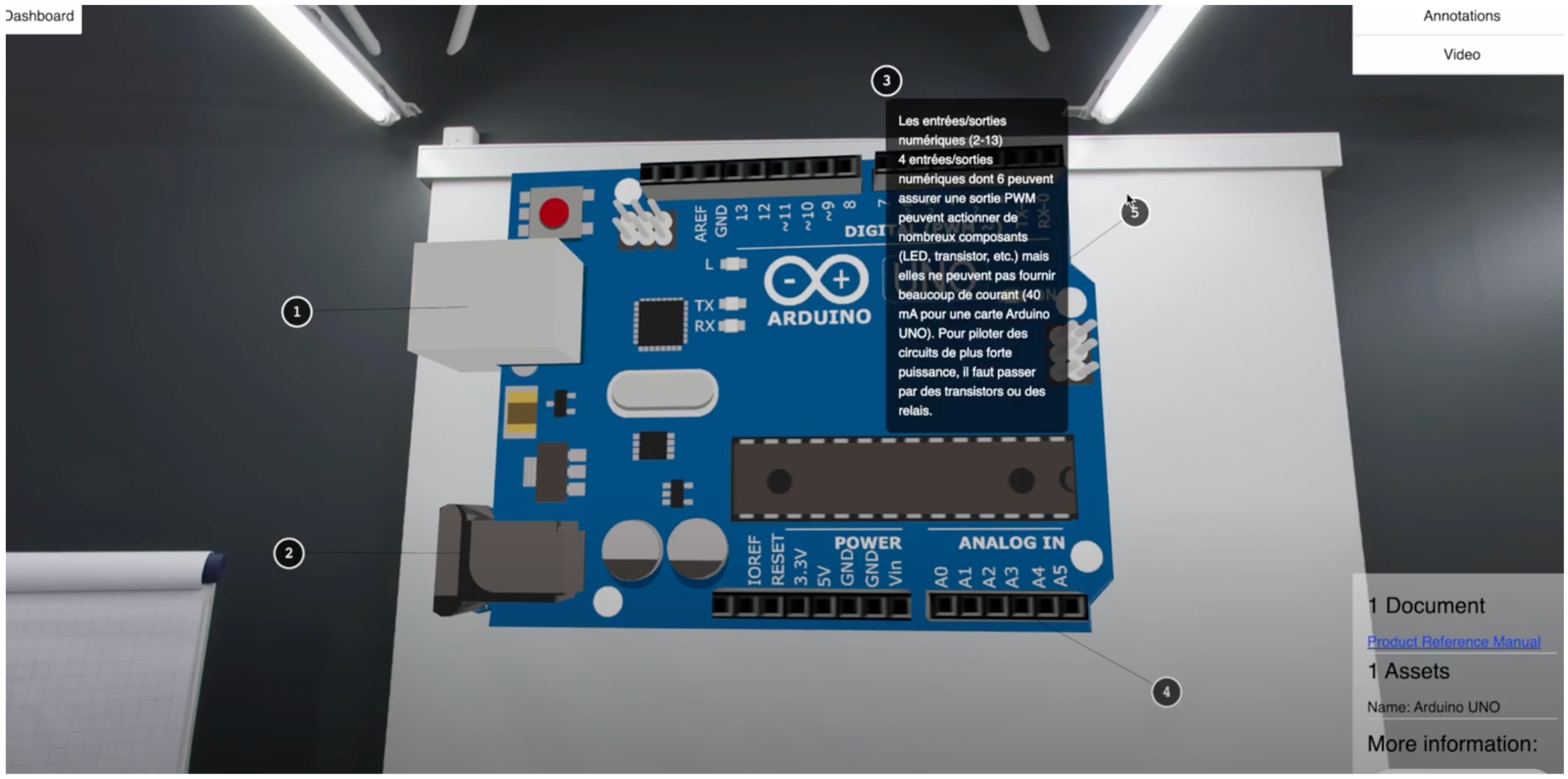
Fig. 5.
Annotations on 3D assets. Side view of annotations while moving around the 3D asset in the virtual space.
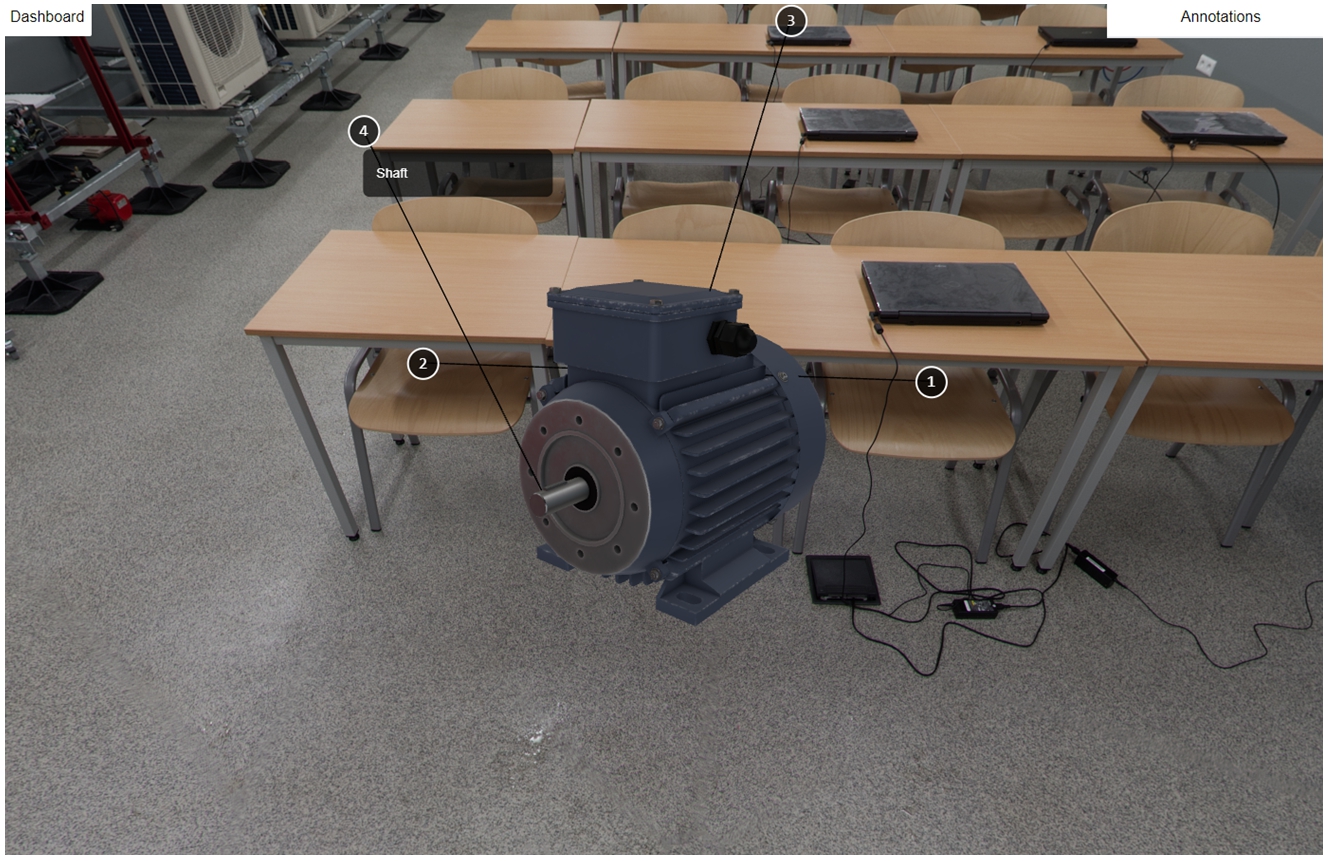
The teacher’s dashboard provides access to resources to manage courses they create. When the teacher logs in, a virtual asset to the environment can be added along with annotations for specific points in the 3D object; when we click on the “Annotation” button we can see annotation numbers around the object with the possibility to show/hide details on click. Another feature is to add a video to play in the virtual space, so the students can hide the 3D object and watch the video with all Youtube possibilities like watching in full screen. In addition, there is another option to add audio as a voice explanation. To keep all 2D options and features, we can preview a document with the option to print, full, screen, zoom, scroll, and all others that can be provided by the used browser to preview a PDF document.
Fig. 6.
The video or audio (bottom right of the screen) features playing in the virtual space.
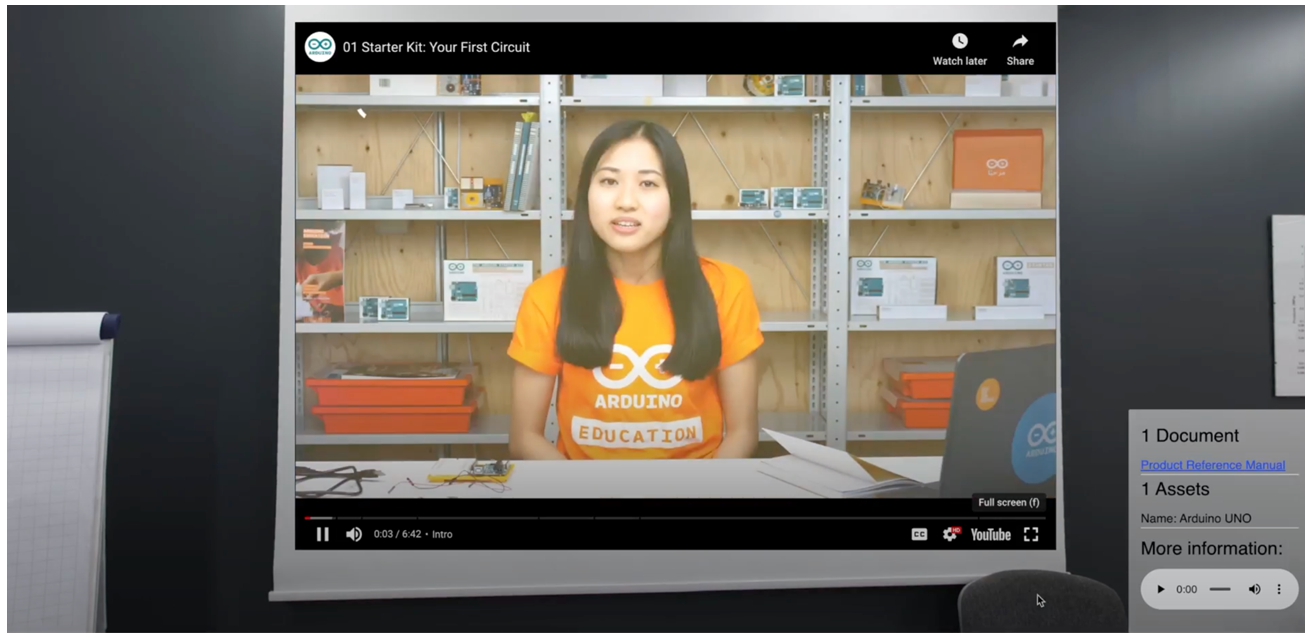
Fig. 7.
Document preview from the virtual environment.
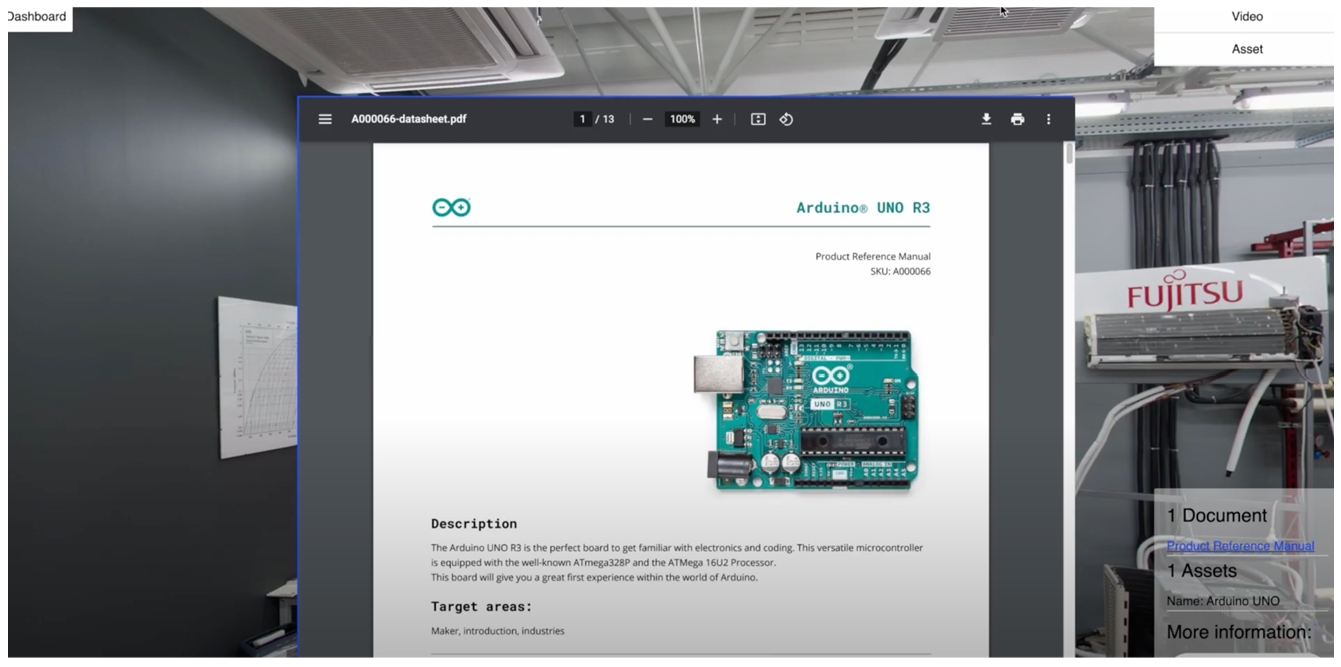
4.5.The safety aspect of immersive experiences
The foundational principle of ensuring user safety and security within immersive learning environments underscores every aspect of our platform’s architecture. In the realm of data privacy, we employ cutting-edge encryption protocols that encompass end-to-end data transmission, safeguarding sensitive user information from interception or unauthorized access. The authentication infrastructure is fortified through the seamless integration of industry-standard protocols, leveraging OpenID Connect and OAuth 2.0 for a robust Single Sign-On (SSO) mechanism. This not only elevates user security but also streamlines access management across multiple web platforms, offering a unified and secure authentication experience. Intrusion detection and prevention systems are intricately woven into our platform’s fabric, proactively identifying and mitigating potential threats in real-time. Our commitment to safety extends to the architecture’s core, ensuring a secure learning ecosystem where educators and learners can confidently engage with immersive experiences that are shielded by a dynamic amalgamation of encryption, authentication, and intrusion management measures.
5.Conclusion and perspectives
COVID-19 has accelerated digital transformation in several industries, including education. The use of new immersive technology in education through virtual reality, augmented reality, and the metaverse is starting to be a reality. In this paper, we present a WebXR-based education platform for engineering. We used a 3D model of an Arduino UNO board to which the teacher added annotations to facilitate access to information for a student participating in this course. As perspectives, we delve into the realm of STEM education enhancement through WebXR technology. Expanding beyond the current landscape, we advocate for the inclusion of an array of diverse courses catering to varied STEM disciplines and educational levels. Our proposed solution involves the integration of intricate 3D models to bolster students’ comprehension of complex concepts. To ensure an immersive learning experience, we emphasize the fusion of text, images, videos, and files to convey information effectively. Moreover, we highlight the critical aspect of user interaction and tracking, allowing for personalized learning journeys. At the culmination of each course, we propose the integration of comprehensive reviews and assessments to solidify student understanding. In a pioneering stride, we also present an in-depth analysis of the impact of our WebXR solution on teacher improvement, investigating how educators’ pedagogical skills can be enhanced through interactive and data-driven experiences, thereby fostering a holistic STEM education ecosystem.
Teachers may need to use technology as a support for their courses, but most of the tools are for assistance only or a fully virtual experience in the 2D format. Our objective is to simplify the tool so teachers can create their courses following their pedagogy in a fully immersive experience.
We would like to evaluate the solution that we are working on by gathering feedback from teachers of STEM from different institutions and improve the solution until we get a satisfactory result so teachers can easily create their XR content for their students, also we would like to study the student’s behavior and include AI and IoT technologies to improve the students learning and make it easier for the teachers to become facilitators.
Conflict of interest
None to report.
References
[1] | G. Billingsley, S. Smith, S. Smith and J. Meritt, A systematic literature review of using immersive virtual reality technology in teacher education, J. Interact. Learn. Res. 30: ((2019) ), 65–90. |
[2] | M. Dunleavy, Design principles for augmented reality learning, TechTrends. 58: ((2014) ), 28–34. doi:10.1007/s11528-013-0717-2. |
[3] | M.A. Gigante, 1 – virtual reality: Definitions, history and applications, in: Virtual Real. Syst., R.A. Earnshaw, M.A. Gigante and H. Jones, eds, Academic Press, Boston, (1993) , pp. 3–14. doi:10.1016/B978-0-12-227748-1.50009-3. |
[4] | Immersive Web Developer WEBXR – supported browsers, (n.d.). https://immersiveweb.dev/#supporttable (accessed April 3, 2023). |
[5] | S. Joshi and P.J. Pramod, A collaborative metaverse based A-la-carte framework for tertiary education (CO-MATE), Heliyon. 9: ((2023) ), e13424. doi:10.1016/j.heliyon.2023.e13424. |
[6] | M.A. Kuhail, A. ElSayary, S. Farooq and A. Alghamdi, Exploring immersive learning experiences: A survey, Informatics. 9: ((2022) ), 75. doi:10.3390/informatics9040075. |
[7] | N.G. Lederman, D.L. Zeidler and J.S. Lederman, Handbook of Research on Science Education: Volume III, 1st edn, Routledge, New York, (2023) . doi:10.4324/9780367855758. |
[8] | B. Marks and J. Thomas, Adoption of virtual reality technology in higher education: An evaluation of five teaching semesters in a purpose-designed laboratory, Educ. Inf. Technol. 27: ((2022) ), 1287–1305. doi:10.1007/s10639-021-10653-6. |
[9] | S. Mystakidis, Metaverse, Encyclopedia. 2: ((2022) ), 486–497. doi:10.3390/encyclopedia2010031. |
[10] | S.-M. Park and Y.-G. Kim, A metaverse: Taxonomy, components, applications, and open challenges, IEEE Access. 10: ((2022) ), 4209–4251. doi:10.1109/ACCESS.2021.3140175. |
[11] | A. Pregowska, K. Masztalerz, M. Garlińska and M. Osial, A worldwide journey through distance education—from the post office to virtual, augmented and mixed realities, and education during the Covid-19 pandemic, Educ. Sci. 11: ((2021) ), 118. doi:10.3390/educsci11030118. |
[12] | F.C. Rodríguez, M. Dal Peraro and L.A. Abriata, Democratizing interactive, immersive experiences for science education with WebXR, Nat. Comput. Sci. 1: ((2021) ), 631–632. doi:10.1038/s43588-021-00142-8. |
[13] | A.M. Rzepka, K.J. Hussey, M.V. Maltz, K. Babin, L.M. Wilcox and J.C. Culham, Familiar size affects perception differently in virtual reality and the real world, Philos. Trans. R. Soc. B Biol. Sci. 378: ((2023) ), 20210464. doi:10.1098/rstb.2021.0464. |
[14] | F. Sanfilippo, T. Blazauskas, G. Salvietti, I. Ramos, S. Vert, J. Radianti, T.A. Majchrzak and D. Oliveira, A perspective review on integrating VR/AR with haptics into STEM education for multi-sensory learning, Robotics. 11: ((2022) ), 41. doi:10.3390/robotics11020041. |
[15] | T.F.A.C. Sigahi, I.S. Rampasso, R. Anholon and L.I. Sznelwar, Classical paradigms versus complexity thinking in engineering education: An essential discussion in the education for sustainable development, Int. J. Sustain. High. Educ. 24: ((2023) ), 179–192. doi:10.1108/IJSHE-11-2021-0472. |
[16] | Snow Crash, (n.d.). https://www.goodreads.com/book/show/40651883-snow-crash (accessed March 15, 2023). |
[17] | D. Vergara, Á. Antón-Sancho and P. Fernández-Arias, Player profiles for game-based applications in engineering education, Comput. Appl. Eng. Educ. 31: ((2023) ), 154–175. doi:10.1002/cae.22576. |
[18] | WebXR – Samples Explainer, (n.d.). https://immersive-web.github.io/webxr-samples/explainer.html (accessed April 3, 2023). |
[19] | WebXR Device API, (n.d.). https://www.w3.org/TR/webxr/ (accessed April 4, 2023). |
[20] | Y. Xie, M. Fang, K. Shauman and S.T.E.M. Education, Annu. Rev. Sociol. 41: ((2015) ), 331–357. doi:10.1146/annurev-soc-071312-145659. |

![How to access a platform developed with WebXR technology [14].](https://content.iospress.com:443/media/scs/2023/2-3/scs-2-3-scs230012/scs-2-scs230012-g001.jpg)



